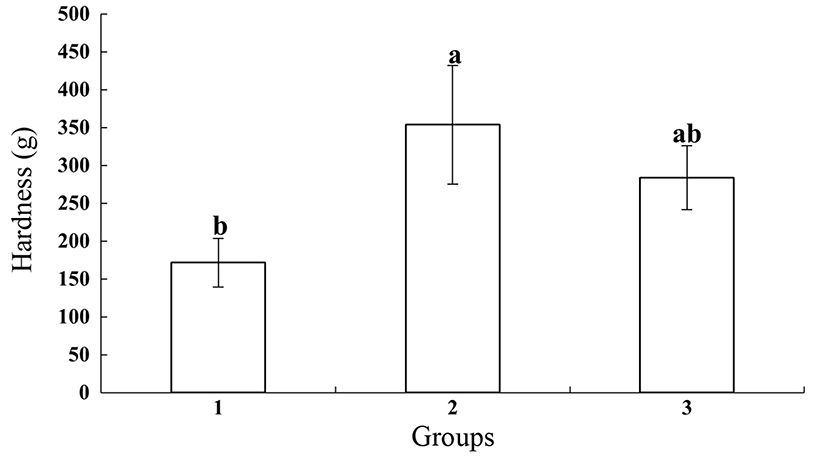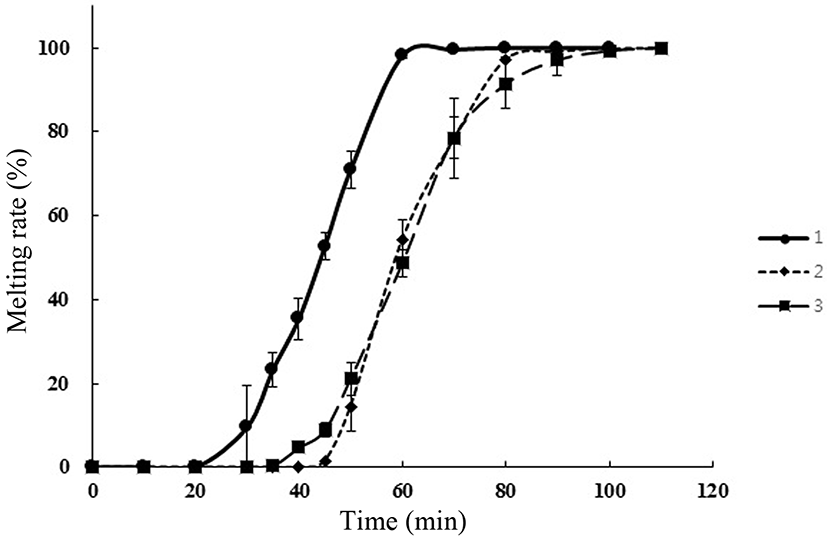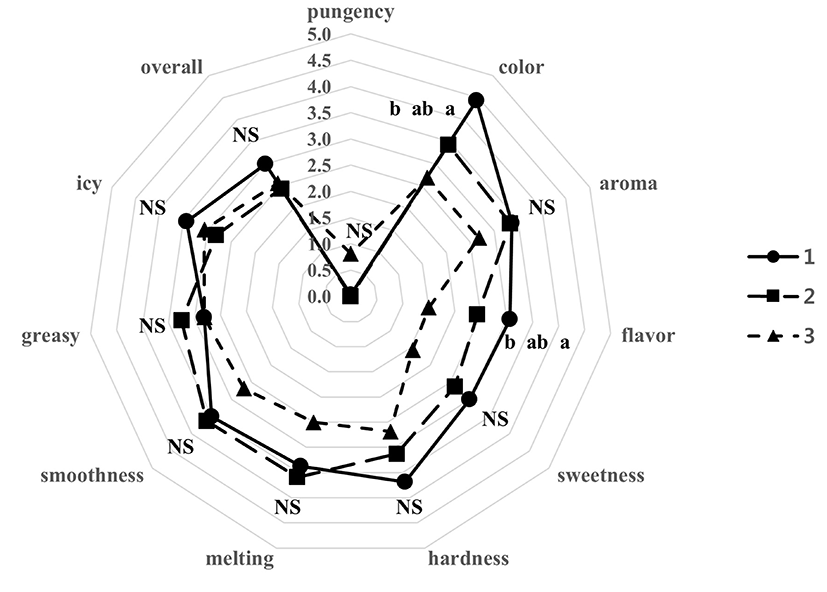Introduction
Ice cream is a frozen dairy food made by freezing pasteurized mix composed of cream, egg yolk, sugar, milk and other materials (Arbuckle, 1986). It has high amounts of fat and sugar, and this can cause harmful effects on blood sugar or lipid metabolism (Her et al., 2005a). When consumed excessively, ice cream can result in lifestyle-related diseases such as diabetes or obesity because of the abrupt increase of blood sugar (Her et al., 2005a; Her et al., 2005b). Consequently, ice cream is not recommended as a dessert for children as well as for diabetic or obesity patients (Kim, 2005). However, ice cream is a favorite dessert for men and women of all ages (Her et al., 2005a; Ko et al., 2014). As a result, many studies have investigated the use of alternative sweeteners in ice cream, such as oligosaccharides and sorbitol instead of sugar (Her et al., 2005a; Her et al., 2005b). Oligosaccharide is a non-digestible saccharide composed of 3 to 10 monosaccharides (Shin et al., 2000). It increases bifidobacteria in the colon (Ballongue et al., 1997) and changes the composition and metabolism of colonic microflora (Gibson and Roberfroid, 1995). Meanwhile, research on health functional foods have increased due to increasing consumer interest in wellbeing. For example, in case of ice cream, Her et al. (2005a) reported on the feasibility of oligosaccharide-supplemented soy ice cream for diabetic patients while Kim et al. (2004) investigated citron added ice cream. Tarak, Korean traditional fermented milk, has also been used to produce ice cream (Ko et al., 2014). In addition, Prapasuwannakul et al. (2014) published a study on the use of green coconut pulp for cream, milk, stabilizers, and emulsifier replacers in ice cream. In this study, ice cream contains fermented pepper powder which has degraded capsaicin.
Pepper is cultivated in Korea, Japan, and America as well as Europ, and contains a lot of nutritional materials such as vitamin, carotenoid and capsaicinoid. Capsaicin (8-methyl-N-vanillyl-6-nonenamide) is the active component in pepper (Capsicum spp.) and has anti-obesity and anti-oxidant effects (Chen et al., 2014; Iwai and Watanabe, 1999; Luo et al., 2011; Yeon et al., 2013). However, it is highly pungent, which prevents the food industry from using capsaicin as a food additive (Kim et al., 2011; Yeon et al., 2013).
Meanwhile, Bacillus licheniformis SK1230 is capsaicin degrading microorganism (Yeon et al., 2013), and it can be isolated from Korean traditional pickled pepper (Cho et al., 2014). Therefore, it suggested that Bacillus licheniformis SK1230 is safe to apply the food products. In our previous study, we fermented pepper using Bacillus licheniformis SK1230 to decrease the pungency (Kim et al., 2011; Yeon et al., 2013). The pungency could be adjusted according to the duration of fermentation. In addition, pepper fermented with Bacillus licheniformis showed an inhibitory effect on body fat accumulation in mice fed a high fat diet (Yeon et al., 2013). Furthermore, yogurt containing fermented pepper juice has decreasing effect on the body fat and cholesterol level in high fat and high cholesterol diet fed rat (Yeon et al., 2015).
In this study, ice cream containing fermented pepper powder was manufactured and the physical and sensory attributes were assessed to investigate the possibility of development about functional dessert.
Material and Methods
Chungyang pepper purchased from a local market (Korea) was ground in a juicer and freeze dried. Powdered pepper concentration in medium for fermentation was determined by preparatory experiments. When the powdered pepper concentration was higher than 4%, it was too thick to incubate with shaking. Accordingly, 40 g of this powder was fermented with Bacillus licheniformis SK1230 in 1 L of Bacillus minimum medium (NaCl 1 g/L, Na2HPO4 9.52 g/L, KH2PO4 6 g/L, NH4Cl 2 g/L, MgSO4 0.48 g/L, CaCl2 0.02 g/L) at 37°C for 28 d to reduce the pungency, and then freeze dried. This powder was used as fermented pepper powder in this study.
To prepare the ice cream, skim milk powder (Maeil skim milk powder, Maeil, Korea), cream (Hopla, Cooperlat, Italy), milk (Maeil milk low fat & high calcium, Maeil, Korea), fracto-oligosaccharide (Beksul oligosaccharide, CJ, Korea), sugar (white sugar, Samyangsa, Korea), egg yolk, vanilla essence and gelatin (Leaf gelatin, DGF STOESS AG, Germany) were purchased from a local market (Korea).
Three formulations of ice cream were manufactured in this study: 1, control ice cream with oligosaccharide; 2, oligosaccharide ice cream with 0.1% fermented pepper powder; and 3, oligosaccharide ice cream with 0.2% fermented pepper powder. Ice cream was prepared by modifying Kim et al. (2004) and Her et al. (2005a)’s methods. Skim milk powder, cream, milk, egg yolk, vanilla essence, and oligosaccharide were homogenized in a bowl (X-10 30D, JEIO TECH, Germany). Heat treatment was applied at 85°C for 2 min, and gelatin was added after cooling to 65°C. The mixture was then aged at 4°C for 20 h. The ice cream mix was frozen in an ice cream maker (PRO3000, NEMOX, Italy) for 17 min. Fermented pepper powder was added to the ice cream mix before heat treatment.
The viscosity of the ice cream mix aged for 20 h was measured using a rotational viscometer (LVDVE230, Brookfield, USA) with spindle LV-4 (64) at 3 rpm. During measuring, all samples were in the cold water to prevent the change of temperature.
Overrun was calculated with the following equation (Ioanna et al., 2004).
where W1 = weight of the constant ice cream mix volume and W2 = weight of the same volume of ice cream.
The hardness of the ice cream was measured using a texture analyzer (CT3-10KG, Brookfield, USA) with a 6 mm stainless steel cylinder probe (TA-BT-kit, Brookfield, USA). The speed was 1.0 mm/s, the target value was 1.5 mm, and the trigger load was 5 g.
Melting rate was determined by measuring the weight of the melting ice cream at 25°C. Thirty gram of ice cream was placed on a mesh attached to a cylinder, and the ice cream that dripped through the cylinder was weighed.
The color of the manufactured ice cream was measured using a colorimeter (CR-400, Konica Minolta, Japan).
The sensory properties of the ice cream such as aroma, melting, hardness, smoothness, iciness, pungency, and the overall properties were analyzed by 8 panelists. All samples were presented in a plastic cup. Pungency was evaluated by the degree of intensity, and the other properties were assessed hedonically on a scale of 1, for very poor and weak, to 5, for very excellent and strong.
Results and Discussion
The viscosities of the ice cream mixes are shown in Table 1. Formulas 2 and 3 showed significantly higher viscosity than formula 1 (p<0.05) but there is no significant difference between two fermented pepper powder ice creams (p>0.05). Mucilage is produced during fermentation and the substance becomes sticky. When the pepper was fermented, mucilage also produced. The high viscosity of formulas 2 and 3 might be resulted from this mucilage.
The calculated overrun is shown in Table 2. As opposed to the results for viscosity, higher additive content ice cream resulted in more overrun (p>0.05), and the ice creams containing fermented pepper powder had significantly less overrun than the general ice cream (p<0.05). This might be related to viscosity; if the viscosity of the mix is high, less air enters the ice cream during the manufacturing process (Prapasuwannakul et al., 2014). Consequently, formulas 2 and 3, which have high viscosities, would have less overrun (p<0.05).
| Group | 12) | 23) | 34) |
|---|---|---|---|
| Viscosity (cP1)) | 4966.7±233.81b | 7666.7±900.37a | 6960±433.59a |
| Overrun (%) | 20.3±1.13a | 13.0±0.99b | 14.8±0.18b |
cP1), Centi-poise; 12), Basic ice cream with oligosaccharide; 23), Oligosaccharide ice cream with 0.1% fermented Chungyang pepper powder; 34), Oligosaccharide ice cream with 0.2% fermented Chungyang pepper powder.
a,bsuperscripts with different letters are significantly different (p<0.05). * all values are mean±S.D. for three samples.
The hardness measurement results for the 3 ice creams were the reverse of the overrun results (Fig. 1). Even though there is no significant difference, an additive-dose dependent decrease was observed (p>0.05). Muse and Hartel (2004) reported that ice cream with high overrun tends to be soft, and the inverse relationship between hardness and overrun exist (Goff et al., 1995; Tanaka et al., 1972; Wilbey et al., 1998). In this study, this inverse relationship between hardness and overrun could be identified, too. Moreover, numerous factors such as fat network, ice phase volume, ice crystal content and ice crystal size influence hardness (Sakurai et al., 1996; Wilbey et al., 1998).
The color measurement data is presented in Table 3. The brightness was decreased by increase of addition amount of fermented pepper powder (p<0.05). Fermented pepper powder appears light brown in color. Hence, formulas 2 and 3 expressed significantly higher redness and yellowness comparing to control (p<0.05).
| Group | 14) | 25) | 36) |
|---|---|---|---|
| L1) | 87.2±0.21a | 86.2±0.10b | 79.8±0.33c |
| a2) | −3.6±0.02b | −3.1±0.01a | −3.1±0.02a |
| b3) | 15.4±0.13c | 16.3±0.06b | 17.7±0.11a |
L1), Brightness; a2), Redness; b3), Yellowness; 14), Basic ice cream with oligosaccharide; 25), Oligosaccharide ice cream with 0.1% fermented Chungyang pepper powder; 36), Oligosaccharide ice cream with 0.2% fermented Chungyang pepper powder.
a-csuperscripts with different letters are significantly different (p<0.05). * all values are mean±S.D. for three samples.
The melting rate is shown in Fig. 2. Ko et al. (2014) reported that the melting rate is related to air content, fat size, ice crystal size, etc. In addition, Muse and Hartel (2004) mentioned the fat network plays a key role in determining the melting rate of ice cream. According to Prapasuwannakul et al. (2014), melting rate may be related to viscosity, hardness, and overrun. Formulas 2 and 3 maintained their appearance much longer than formula 1 at room temperature. Sofjan and Hartel (2004) reported that lower overrun ice cream melted more rapidly. In this study, the high viscosity of formulas 2 and 3, even if it have lower overrun than control, may have been responsible for their longer form retention, as sticky mucilage from the fermented pepper powder may play a role in maintaining the ice cream form.
Fig. 3 expresses the sensory attributes for the 3 kinds of ice creams. Even though there was no significant difference, Formula 3 had the strongest pungency because of remaining capsaicin in fermented pepper powder. According to the previous study, if the fermentation time was longer, this pungency could be decreased more (Yeon et al., 2013). With regard to aroma and melting, formula 2 scored highest among 3 groups and showed no significant difference from control (p>0.05). Moreover, there were no significant differences among the 3 formulas (p>0.05) in smoothness, iciness and overall properties. Therefore, in sensory properties, ice cream containing fermented pepper powder demonstrated similarity to the control formula, especially 0.1% supplemented fermented pepper ice cream does with lower pungency.
Conclusion
Ice cream containing fermented pepper powder maintained physical and sensory properties similar to the controls, and maintenance was better. It means fermented pepper powder ice cream can be utilized as the material of functional food. Therefore, it suggested that fermented pepper powder may have very important roles to produce better qualities of ice cream in physical and sensory areas. Further studies are needed to determine the functional effects of ice cream containing fermented pepper powder such as its anti-obesity.
















